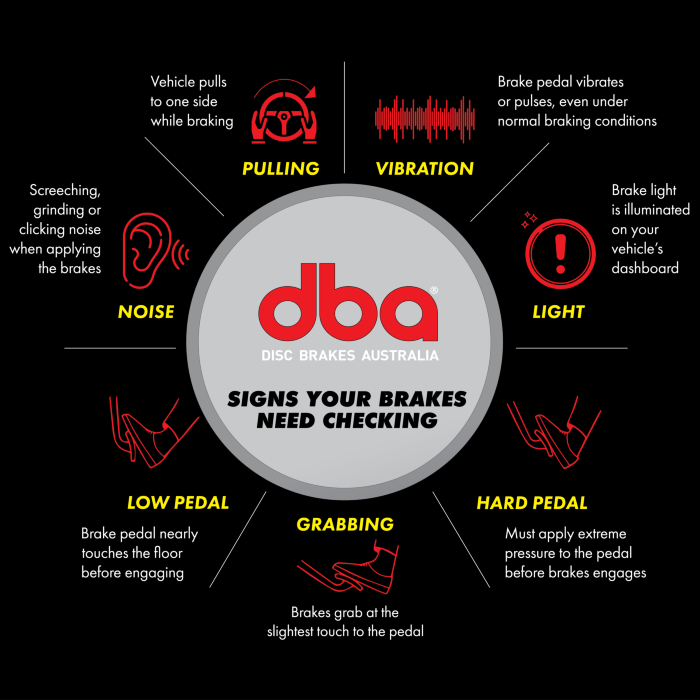
Most drivers will only have their brakes inspected when they run into a problem; hence many rotors, pads and auxiliary components are kept beyond their proper and safe use-by dates.
Reminding yourself and your customers of the importance of regular brake inspections will not only ensure a safe ride for your customer, but help you generate revenue from servicing, replacing and potentially upgrading the brakes whenever it is warranted to do so.
So check out our review of some of the most common brake issues.
Usually indicates a leak in the brake system which poses a serious safety hazard. The callipers, wheel cylinders, brake hoses, brake lines, and master cylinder all need to be inspected. If a leak is found, the defective component must be replaced or rebuilt. The vehicle should not be driven until the repairs can be made because a leak may lead to brake failure.
Can result if shoe adjusters on drum brakes stick and fail to compensate for normal lining wear. Adjusting them may restore a full pedal, but unless the adjusters are cleaned or replaced the problem will return as the linings wear. Other causes include worn brake linings or a fluid leak.
Means there is air in the brake system either as a result of improper bleeding, fluid loss or a very low fluid level. The cure is to bleed the brakes using the sequence recommended for the specific vehicle. Another possible cause is a rubber brake hose that is “ballooning” when the brakes are applied.
Possible causes include worn brake linings, misadjusted drum brakes, and air in the brake lines. Potentially dangerous because the system may run out of pedal before the vehicle can be safely stopped.
A dangerous condition caused by worn internal rubber seals in the master cylinder or a leak in the hydraulic system will not allow the brakes to hold pressure.
Indicates DTV and the brake rotor needs to be resurfaced or replaced. The faces of a rotor must be parallel (within 0.0005 inch / 0.0127mm on most cars) and flat (no more than about .002 inches or 0.050 mm of runout). Don’t forget the wheel bearings (if serviceable) – they will need to be cleaned, inspected and repacked with grease. New grease seals will also be needed.
Indicates a torque variation in the brakes. This is commonly associated with friction material deposits on the disc rotors causing a grab and release motion. The intermittent torque from left to right pulls on the steering rack and transfers to the steering wheel. Steering wheel vibration can also indicate DTV when combined with a pedal pulsation. Check for friction material deposits (dark patches) first.
Commonly caused by rotors that have been machined incorrectly and process was not properly finished.
Usually indicates metal-to-metal contact and the need for a long overdue brake job. Drum and rotor replacements will likely be needed in addition to new linings and brake hardware. Some disc pads have wear indicator warnings fitted which give out a screeching sound, this means the brakes need immediate attention.
Commonly caused by vibrations between the disc pads and calliper, which may be cured by resurfacing or replacing the rotors, installing new pads and pad shims, or applying brake grease or noise compound to the backs of the pads.
Oil, grease or brake fluid on the linings will cause them to grab. The cure is to identify and eliminate the source of contamination, and then replace the linings. Badly scored drums or rotors can also grab. Resurfacing or replacement may be needed.
May create a steering pull and/or increased fuel consumption. Caused by weak or broken retracting springs on drum brakes, a jammed or corroded calliper piston, or a floating calliper with badly corroded mounting pins or bushings, brake callipers should be overhauled every 60,000 kms (uneven pad wear is a clue here). Another cause might be an overextended drum brake self-adjusters or a sticky or frozen emergency brake cable. It causes extreme wear, excessive temperature and can mean lower performance in emergencies.
Caused by contaminated linings, misadjusted brakes, a bad wheel cylinder or calliper, dragging brakes on one side, or loose wheel bearings. It can also be caused by a mismatch of friction materials side-to-side on the front brakes or differences in rotor thickness, type or condition.
Lack of power assist may be due to low engine vacuum, a leaky vacuum hose or a defective booster. Sometimes a faulty check valve will allow vacuum to bleed out of the booster causing a hard pedal when the brakes are applied. This condition can be diagnosed by pumping the vacuum out of the system while the engine is switched off, then start the engine while the brake pedal is depressed. If there is a sinking feeling when the engine is started the power assist booster is working. After trying this if there is no pedal drop, the power assist booster may need attention, or there may be a blocked vacuum hose, or a new check valve is needed.
Is hygroscopic which means it absorbs moisture, as this happens the boiling point of the brake fluid drops dramatically, which causes it to boil, therefore loss of brakes will occur. Fluid should be replaced every 2 years or 60,000 kms. When flushing new brake fluid through the system, make sure the master cylinder reservoir has been cleaned so not to flush any contamination through the brake system.
For further information contact DBA on 1800 730 039, visit www.dba.com.au, or find us on Facebook.
This article is brought to you by Mechanic.com.au Premier Community Partner DBA